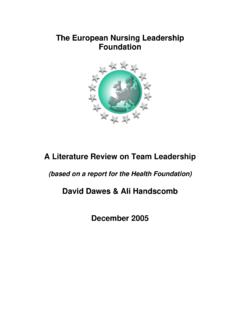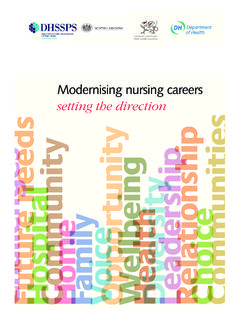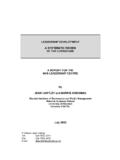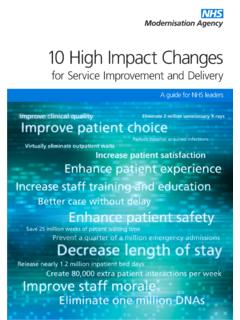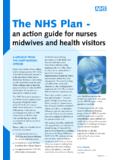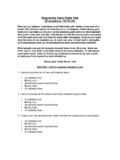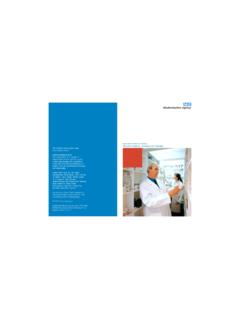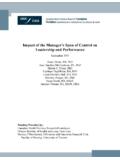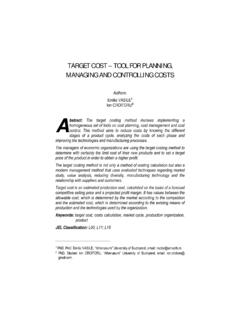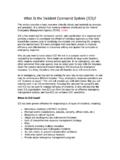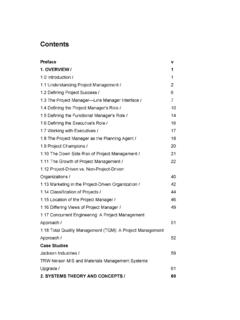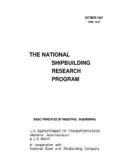Transcription of A guide to ward staffing budgets - Nursing Leadership
1 A guide to ward staffing budgets CONTENTS. Introduction 3-4. SECTION 1 budgets 5-10. SECTION 2 managing & controlling spend 11-14. SECTION 3 How is the Health Service financed? 15-18. SECTION 4 Benchmarking & sharing best practice 19-20. SECTION 5 Preparing a Business Case & 21-24. managing Change SECTION 6 managing the Nursing resource 25-32. SECTION 7 Leadership Skills 33-38. SECTION 8 Numerical Exercises 39-42. SECTION 9 Practical Case Study & Workings 43-55. Answers 56-58. Summary 59. 2. Introduction The Secretary of State for Health, The Right Honourable Alan Milburn, announced at the CNO annual Conference (Harrogate). 2001 that the Modernisation Agency will, over the next 12 months, lead a management programme to support the devolution of staffing budgets to those ward sisters and charge nurses in England's hospitals who do not yet have that control.
2 He states that ward sisters and charge nurses are in the best places to know the day to day needs of patients and the hour by hour demands on staff. It is because they understand that they should be in control. They should be able to decide the mix of grades, the mix of skills, the mix of jobs they need on the ward. Patients on a ward, particularly the elderly and most vulnerable, need caring skills alongside clinical skills. Some feel that over the last few decades these caring skills have got lost. I believe it is time to re-emphasise them. That is why we have placed such a strong emphasis on cleaning up the wards, improving the food and introducing new jobs such as ward housekeepers to make sure that patients day to day needs are being met.
3 Meeting patients'. needs will be enhanced by allowing ward sisters to decide the number and mix of nurses, care assistants and ward housekeepers. It will be the job of matrons to support ward sisters and charge nurses to discharge these functions.. Many ward sisters/charge nurses already have control of their ward staffing budgets . This guide is aimed at both those who already have responsibility for managing their budgets and those who currently do not. It is therefore seen as a learning aid, and developmental tool, for all ward sisters and charge nurses. In order to ensure that they are fully equipped with the necessary skills and information, this guide examines fundamental aspects of budgeting and budgetary control.
4 It also looks at Leadership skills which are essential for managing the budget effectively. 3. The guide is divided into nine sections budgets . managing & controlling spend. How is the Health Service financed? Benchmarking & sharing best practice. Preparing a Business Case & managing Change. managing the Nursing resource. Leadership Skills. Numerical Exercises. Practical Case Study. Each section includes case studies to help practically illustrate each subject area. 4. SECTION 1. budgets . budgets are used to plan and control operations and finance by the majority of organisations. Defining budgeting budgets and budgeting can be defined in a variety of ways depending on the individual or organisation.
5 However, to budget is generally to determine how much cash is available to an individual/organisation. A budget will provide you with a costing for both income and expenditure. Why are budgets used? budgets are used to plan, monitor, control and measure performance. A budget will be set at the beginning of each financial year (a financial year runs from April 1st to March 31st). Actual spend is then compared with the original budget allocation. Reasons will then be identified for overspend or underspend, which are referred to as variances in the budget statement. Action is then taken to control any variances and the budgets will be reviewed on the basis of this information.
6 ACTION 1. Think about your own personal finances outgoing . mortgage/rent/car/food and incoming salary/interest from investment. 5. What is a balance sheet? A balance sheet is a financial snapshot of your business and thus includes: Assets = An asset is something that your business owns: Assets can be: Current cash, accounts, prepaid rent, or, Fixed furniture, equipment. The statement is normally broken down into staff and non-staff costs. Staff costs will include: Salaries Overtime Training Non staff costs include: Supplies dressings, bedding etc. Drugs Equipment Each cost will then be aligned to a cost centre, which again vary from Trust to Trust. The cost centre is an area of accountability for expenditure Drugs will have a unique cost centre.
7 Each department has a cost centre and each type of cost has an account code. For example Cost Centre 1665 = Orthopaedics Account Code 17753 = Nurse - Grade F. If there are cost centres within your budget which you do not understand or you do not know what they are aligned to, your accountant will have this information and should provide you with a print out of all cost centres and cost codes. The statement will then have sub total costs for each section and a total cost for a given period. 6. A budget statement will hold all income and expenditure within a given period. The statement will typically be as follows, however, there will be variations on this by Trust. budget columns What do they mean?
8 budget Amount available to spend Actual spend Monies already spent to date. This will probably be by month and a year to date figure, which will show how much money has been spent out of the budget from the beginning of the financial year. Staff Number of staff in post displayed as Whole Time Equivalent'. Forecast This figure relates to the amount of funds that are expected to be spent in each area for a given period. Variance This is calculated by subtracting actual spend from planned /forecasted spend. This will be shown as a positive or negative. Amount remaining This is the amount of funds left that are available to spend. Regular meetings with your accountant will help to explain any areas of confusion.
9 This will also provide an opportunity to highlight any areas of overspend and discuss possible options related to this. managing a budget can be quite a lonely task and at times it can feel as if you have no support. Involving all members of staff on your ward is beneficial for a number of reasons: Provides another perspective. Helps to discuss matters relating to costs. Can be used to train other staff in budget management . which would be developmental for junior staff. Ward sisters/charge nurses may sometimes be seen as the bad guy' when saying no to requests. Involving staff would allow them to see the reality of what monies are available. Encourages staff to work as a team, promotes involvement.
10 7. By also involving medics and pharmacists in these discussions, it ensures that all members working on the ward have full knowledge of the budget . Matters of importance can be raised, for example the use of drugs can be discussed. For effective use and control of funds the budget should be viewed as every individual's responsibility. Resource/Link people It is essential to make links with key people/departments within an organisation Supplies Liase with supplies to look at competitive options for products. Look at stock levels which you currently hold, rather than topping up' with each supply order, discuss with other members of staff to determine what is needed and the amount which is required.
